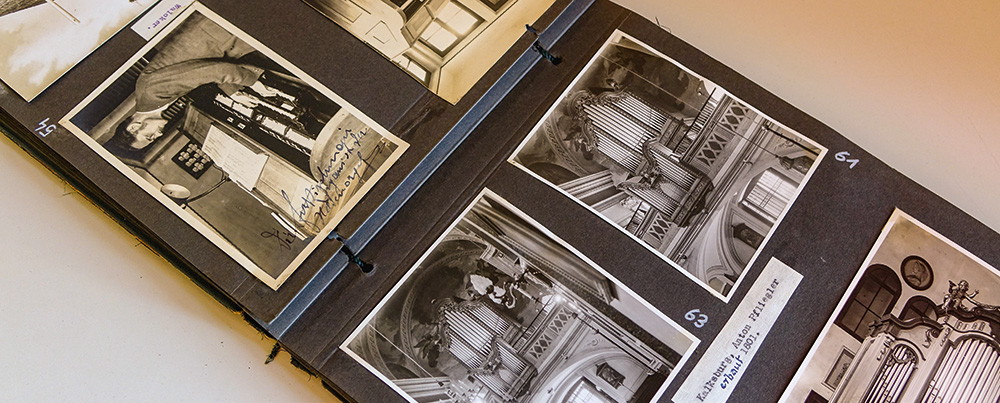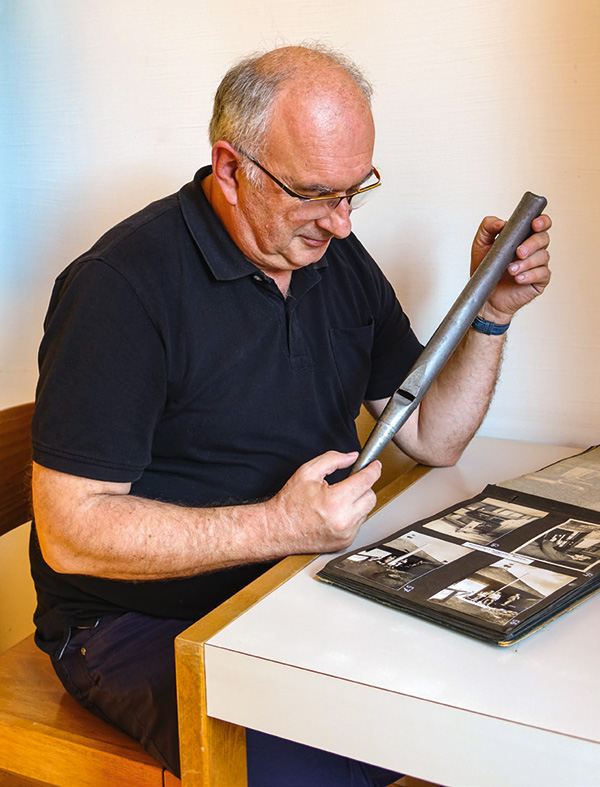Thousands of slides, photos, documents, and other organ-related materials surround Wolfgang Kreuzhuber at Lothringerstraße 18. This location is home to Austria’s only institution for organological research specifically on organs—the Organ Research Centre—which Upper Austria native Kreuzhuber heads.

The range of activities pursued by the mdw’s Organ Research Centre (Zentrum für Orgelforschung) is broad: alongside field research, preserving and studying collections and items from individuals’ estates, publishing on topics related to Austrian organ-building, holding symposia, and archival and teaching work all number among the responsibilities of the Centre, which is unique in Austria and has been headed by musicologist and organist Wolfgang Kreuzhuber since 2003.
The Development of Research on Organs
The history of organ research at the mdw goes back quite a long way: 1971 saw the establishment of the Institute of Organological Research and Documentation at what was then the Academy of Music and Performing Arts Vienna, and Karl Schütz—this institute’s sole full-time employee—worked from 1972 onward to compile a collection of data on organ-building alongside his regular work as an instructor.
In 2002, a step was taken that entailed myriad structural changes: the existing institute was attached to the mdw’s Department of Organ, Organ Research, and Church Music as the Organ Research Centre. 2003 then saw responsibility for organ research pass to Wolfgang Kreuzhuber—and today, Kreuzhuber is supported by Sepp Strobl in terms of research and by Andrea Palecek administratively.

Slides, Documents, Books, and Visual Materials
Over 20,000 slides, 1,500 photos, countless documents (from disposition designs to technical drawings and on to cost estimates), and abundant visually interesting material—from organ models to tuning tools—can be discovered at the Organ Research Centre. And the Centre is especially proud of some veritable treasures that can be found in its collection—including a pipe from the Principal group of the Römer Organ, which was built in 1720.
Alongside bequests from individuals such as Hans Heiling, Arnulf Klebel, and Ferdinand Molzer, the Centre also includes a reference library containing organological literature, student research works such as theses and dissertations, and the first three publications on organ-building from the series Wiener Beiträge zu Orgel und Kirchenmusik [Viennese Contributions on Organ and Church Music], which was established by Wolfgang Kreuzhuber and is published by the Department of Organ, Organ Research, and Church Music.
An Essential Resource for Restoration Projects
With its work, the Organ Research Centre supports the restoration of various organs such as the Wöckherl Organ at Vienna’s Franziskanerkirche and the Pfliegler Organ in Hafnerberg, Lower Austria. Organological research is indispensable to such projects, and every time an organ can be appropriately restored thanks to support from the Centre, it is a special and unique occurrence.
Support for Enquiries with the Organ Database
Since its founding, the Organ Research Centre has handled countless written and spoken inquiries from all over Austria and from neighbouring countries; answering questions about organs built in Austria, providing support for research work regarding details of organ construction, and providing information on the disposition of certain instruments are just of the few ways in which the Centre has provided assistance. Swift answers are possible thanks to the Centre’s electronic database, the product of years of intensive work. And once the Centre’s project of cataloguing all organs in Austria has been completed, over 6,000 instruments will have been entered into its database—an impressive figure.
A great deal of time and energy has been spent by the organ research team on this project in recent years—and for the future, there still remains much to do: despite how wonderful it is to have already collected such a large body of material on organ-building in Austria, it does need to be mentioned that this initial cataloguing of all instruments in Austria will still require much research and analytical work. And completing this database on Austrian organ-building is an important priority, even if severe limitations on personnel and financial resources mean that making progress isn’t always easy.
(Inter)National Contacts and Cooperation
It will take continued collaborative effort on the part of all those involved—organ-builders, organists, and organ enthusiasts—to continue the Centre’s thorough documentation of Austrian organ-building in its historical dimension, which is why 2004 saw creation of the Austrian Organ Forum, which is based at the Centre. The close cooperation between these two institutions gives rise to valuable synergies. And for similar reasons, a great concern is also to maintain and intensify contact with national and international institutions—from the Göteborg Organ Art Center (GOArt) to the International Association for Organ Documentation (IAOD)—as well as to help build up organ research bodies in the new EU states.
Practice-Oriented and Interdisciplinary Offerings for Students
The objective here is to introduce students to scholarly work in the field of organ research and to reinforce its connection to the practice of organ-building itself. Regular courses on organ-building and general organ study are likewise offered. And field trips to organ-builders, pipe-makers, and important instruments in Vienna and environs, plus seminars on organ maintenance, make it possible for organ and church music students at the mdw to approach this field in a practice-oriented manner. Insights into details of organ-building technique provide organists with new knowledge that can even have lasting effects on their own interpretation of works for organ, thus further serving to raise awareness of the connection between organ-building and organ-playing.
- Website of the Organ Research Centre: www.mdw.ac.at/iok/zfo/ (in German)

